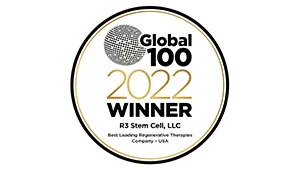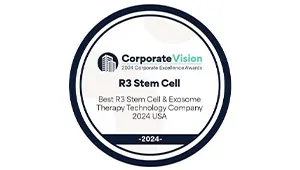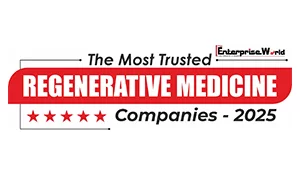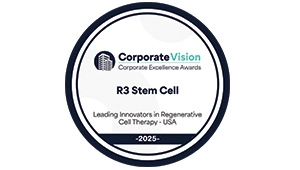Why is Wharton’s Jelly so Popular Now in Regenerative Stem Cell Biologics?
For the past eight years, R3 Stem Cell’s Centers in the US and internationally have performed over 15,000 regenerative procedures. A lot of them have included umbilical cord wharton’s jelly biologics as a source of mesenchymal stem cells.
What exactly is umbilical cord wharton’s jelly?

The umbilical cord itself is a structure connecting the placenta to the developing fetus. It is the primary means of nourishing the growing fetus. At term, the umbilical cord is usually between 40 and 60cm, and its diameter is about 2cm.
First of all, the name “Wharton’s Jelly” was derived in the 1600’s from Dr. Thomas Wharton, who first described it. It is a gelatinous substance within the umbilical cord, that surrounds the two umbilical arteries and the one vein. Interestingly, Dr. Wharton knew nothing about any “cells” in the jelly, as cells themselves weren’t actually discovered until a decade later!
Wharton’s jelly is mostly mucoid connective tissue. One of its functions during fetal growth is to prevent kinking of the blood vessels as the fetus moves in the womb.
Over 90% of Wharton’s Jelly is comprised of collagen, glycoprotein, hyaluronic acid, chondroitin sulfate and other plasma proteins. Over the past decade, numerous researchers have shown wharton’s jelly to be chock full of mesenchymal stem cells, in every region of the space.
The discovery that WJ provides a source of MSCs was first highlighted in McElreavey et al. (1991). Not until 2004 when the first report providing robust evidence that WJ-stromal cells can be classified as MSCs was published (Wang et al., 2004).

The highest density of MSC’s have been seen in what is called the “perivascular tissue”, which surrounds the blood vessels. In this area, researchers have seen mesenchymal stem cells with a distinct propensity of colony forming units (CFU’s), which are indicative of significant self renewal capability. These researchers also showed that one out of every 300 cells obtained from this “perivascular tissue” was an MSC with CFU propensity.
One impressive thing about Wharton’s Jelly is that there are no ethical issues obtaining the tissue. FDA regulated labs in the United States obtain the tissue from a donor after a scheduled c-section. Normally, the umbilical cord is considered medical waste. But in these cases, the umbilical cord is donated with the mother being consented and undergoing a considerable amount of medical screening beforehand.
The Wharton’s jelly is processed at FDA regulated labs very carefully. R3 Stem Cell only works with labs who are cGMP compliant, do not use radiation, minimal reagents, and less than 10% cryopreservative. This way, the highest amount of mesenchymal stem cells survive the processing and freezing, and also retain their activity during therapy.
Moreover, several reports showed a relatively high expression of pluripotency markers in WJ-MSCs compared to MSCs from other sources, implying a more primitive status (Fong et al., 2011; El Omar et al., 2014). This means they are able to turn into MANY different cell types, but have also been shown not to form any tumors!
Mesenchymal stem cells from Wharton’s Jelly have been shown to home to areas of inflammation when placed intravenously. This is impressive, as IV’s are safe and minimally invasive.
How do Wharton’s Jelly Mesenchymal Stem Cells Work?
A growing body of evidence is showing that Wharton’s Jelly MSC’s exert their beneficial effects through several mechanisms:
- Immunomodulatory Effects

- Paracrine Actions
- Reducing Inflammation
- Anti-apoptosis
- Angiogenesis
A lot patients think that it’s the administered stem cells that are the ones turning into the specialty cells to help with the repair and regeneration process. While that may happen to a certain extent, research is showing us that it’s NOT the predominant effect.
One of the major effects is the reduction of inflammation. Chronic inflammation has been shown to be present in the body and is a known precursor to many medical conditions including organ failure, arthritis, several types of cancer and more. The biologic’s cells are able to systemically reduce this inflammation, which is one reason why it’s becoming a popular “anti aging” therapy.
The word “paracrine” really refers to the cell to cell communication abilities of the stem cells. They are masters of “telling” other cells in one’s body and other cells and proteins in the biologic what to do in order to facilitate repair and regeneration of damaged tissue. Along with the communication effect, stem cells are helpful in what’s called anti-apoptosis. This just means they are helpful at preventing cell death. So let’s think about this for a second. They help cells stay alive longer, and also facilitate more specialty cells to be created based on the environment in which they situate themselves. So the overall result is a significant increase in the specific cells necessary to repair a damaged area!
Angiogenesis refers to new blood flow creation. For an issue such as peripheral vascular disease or any issue that will benefit from new blood flow, stem cell therapy has been amazing in this regard. Through a complicated process of paracrine actions that include cytokines and growth factors, new blood flow is encouraged to areas in need. This blood flow brings oxygen and nutrients that are helpful in tissue repair, resulting often in patient benefits.

The immune system is vital to humans being able to fight off disease, and at the same time focus on replacement of tissues for normal functioning. At times, the immune system develops “problems”. An example of this is when rheumatoid arthritis results in a process where the body is fighting itself by targeting healthy tissue for destruction. Type 1 diabetes is the same type of phenomenon.
Stem cells are able to modulate the immune system by complicated methods that are just now being understood. This includes promoting “good” interleukins and cytokines, while suppressing harmful ones. This generates a more healthy environment for the body and has been one of the more remarkable functions of stem cell biologics.
All in all, Wharton’s Jelly is now known to be a remarkable source of extremely active mesenchymal stem cells. Patient results have been remarkable with the use of biologics containing these tissues, and as a result their popularity has grown exponentially!
The top wharton’s jelly stem cell product being offered is ReBellaWJ. There are well over a million mesenchymal stem cells for each cc in the product, with a large percentage having the ability to form CFU’s which indicates high activity.
To find out more information and to place an order, visit and call Regen Suppliers at (888) 568-6909.












No Comments